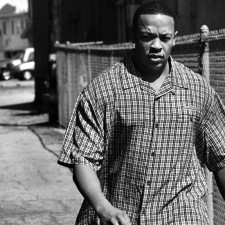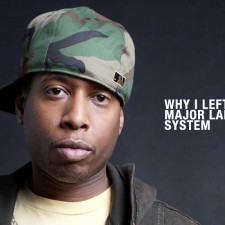 One of the good things about independent films is that they seem to be around at the most convenient times. I recently found myself on a serious “out on the town” in Philadelphia, a jaunt that coincided with the annual meeting of the National Association of Black Journalists. The prior week the National Association of Negro Musicians had met around the corner for its annual convention. Philly was feeling very “cultural,” indeed—what better time to check out a thoughtful film treatment of an important moment in the history of hip-hop?
One of the good things about independent films is that they seem to be around at the most convenient times. I recently found myself on a serious “out on the town” in Philadelphia, a jaunt that coincided with the annual meeting of the National Association of Black Journalists. The prior week the National Association of Negro Musicians had met around the corner for its annual convention. Philly was feeling very “cultural,” indeed—what better time to check out a thoughtful film treatment of an important moment in the history of hip-hop?
Beats, Rhymes and Life: The Travels of A Tribe Called Quest, Michael Rapaport’s new documentary about the super group A Tribe Called Quest, charts their journey from a talented and fun-loving high school crew, to a professional collective that symbolized in its time everything that was “right” about hip hop, to a still talented group of individuals performing the beats and rhymes that shot them to fame in their youth and who now face all the challenges of—it’s hard to say—coming into middle age.
 The best thing about this film is that it captures powerfully the creative, politically-charged, “Can I Kick It?/Yes, You Can” feeling of that moment in the late-1980s to early-1990s when many hip hop artists believed they were summoned to a higher calling than “pop”; when artists thought that record companies believed in this mission; when well-placed radio DJs exercised control over their playlists; when journalists created a specific critical apparatus to mediate it all; and when young people felt empowered, relevant, and affirmed as they connected to the infectious, multi-layered beats and rap’s densely woven narratives.
The best thing about this film is that it captures powerfully the creative, politically-charged, “Can I Kick It?/Yes, You Can” feeling of that moment in the late-1980s to early-1990s when many hip hop artists believed they were summoned to a higher calling than “pop”; when artists thought that record companies believed in this mission; when well-placed radio DJs exercised control over their playlists; when journalists created a specific critical apparatus to mediate it all; and when young people felt empowered, relevant, and affirmed as they connected to the infectious, multi-layered beats and rap’s densely woven narratives.
We hear from many of these cultural workers in the film all testifying to the singularity of Tribes’ artistic and philosophical influence. A wider narrative lens would have placed their work into a broader field of black cultural production. These were, indeed, heady times across the board. Think of Spike Lee’s films, writers Lisa Jones’ and Greg Tate’s journalism at the Village Voice, Lorna Simpson’s and Glen Ligon’s conceptual work in visual culture, and even Wynton Marsalis’ charge at Jazz at Lincoln Center, and you get the point. Tribe was both participant in and a recipient of an insurgence of black creativity at that time, one that worked from an artistic center but found worldwide success.
A prominent thread in the film tracks the reasons for the group’s breakup in 1998. The exploration of the personal angst of this process, one depicted in painful blow-by-blow detail (in one scene Q-Tip and Phife, two of the group’s members, actually have a physical confrontation backstage), while perhaps required for narrative honesty, felt too emphasized. At moments it was like watching Divorce Court despite the measured and thoughtful tenor in which each member expressed his viewpoint. Bands that form in high school, as this one did, will all be challenged by the trials brought on by maturity (i.e, changing personal ambitions, starting families, competition, failing health, and so on). While these topics certainly address the “life” aspect of the documentary’s title, the somewhat sensationalistic treatment here threatened to overshadow why fans loved and continue to revere the group: their beats and rhymes.
 A most compelling feature of Beats, Rhymes, and Life, told in the words of the artists themselves, are explanations of the creative processes that became their stock and trade. Since the appearance of Tricia Rose’s groundbreaking book about hip hop culture Black Noise (1994), writing on the genre has exploded into a cottage industry. Writers deftly consider the music’s social context with an emphasis on the subject matter of the lyrics. What is generally lacking, however, is what we get a glimpse of in the film: how the music is put together.
A most compelling feature of Beats, Rhymes, and Life, told in the words of the artists themselves, are explanations of the creative processes that became their stock and trade. Since the appearance of Tricia Rose’s groundbreaking book about hip hop culture Black Noise (1994), writing on the genre has exploded into a cottage industry. Writers deftly consider the music’s social context with an emphasis on the subject matter of the lyrics. What is generally lacking, however, is what we get a glimpse of in the film: how the music is put together.
We learn that Tribe constituted a delicate ecology of personal and artistic abilities and connections. It’s amazing to witness Q-Tip reveal his insatiable appetite for recordings from all genres. In one scene he’s in a workspace retracing how and from what sources he put together the beat of a track with a turntable. His command and understanding of sound organization could have been the subject of a documentary itself. Combining samples from jazz and sources from across the sonic spectrum, this technique worked well within hip hop conventions but was heard as an expression setting Tribe apart from their contemporaries. As poets, their rhymes or flows cruised the American vernacular for referents that were twisted, cleverly taken out of context, dipped in positive self-awareness, and then employed as wit and “consciousness.”
If Q-Tip is featured as the driven, single-minded artist, then Phife, his rapping counterpart, comes across as the reluctant artist. He’s just as passionate about sports as he is music, and describes writing some of his most compelling and memorable flows while traveling to the recording on the subway. The film depicts the group’s DJ Ali Shaheed Muhammad as accompanists in the worlds of jazz and classical genres are—as studious, observant, and musically keeping the train on the track with an ample skill set, verve and understatement. (I wish we could have gotten a close look at the notebooks that he always carried onstage!). And founding but occasional member Jarobi White says that his participation was about the spirituality of fraternity and support he got from the group. 
Such youthful ecologies are difficult to sustain over time. But as the throngs of screaming fans proved as they turned out for Tribe’s fateful 2008 reunion tour, an event that serves as a frame for this enjoyable documentary: life may change, but rhymes and beats are forever.
Tags: A Tribe Called Quest, Beats, documentary, film, Hip-Hop, Life, Rhymes


 Share On Facebook
Share On Facebook Tweet It
Tweet It





![[Philly EVENT] Screening of Amazing: A Film about Bud Powell](https://musiqology.com/blog/wp-content/uploads/2015/03/bud-powell-225x225.jpg)





